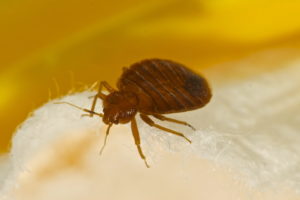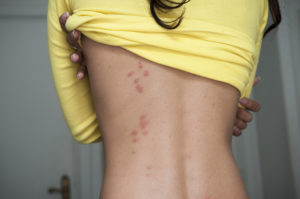How to Get Rid of Bed Bugs in an Apartment?
Table of Contents
- How to get rid of bed bugs in an apartment?
- Can bed bugs spread from apartment to apartment?
- How does pest control process work for apartments?
- How to prevent bed bugs in an apartment?
How to get rid of bed bugs in an apartment?
Bed bugs are challenging pests. They are hard to get rid of, they reproduce quickly, and they hide well. In addition, the egg stage is resistant to many forms of treatment, so a single attempt may not be enough to complete the job. Although some do-it-yourself treatments for apartments may help temporarily, the treatments won’t completely get rid of them.
The following are some ways an apartment tenant or property management can help to eliminate bed bugs on their own:
- Avoiding item clutter in the apartment.
- Washing infested bedding and clothing with hot water for 30 minutes.
- Vacuuming infested areas thoroughly.
- Applying over-the-counter pesticides.
However, the most effective way to get rid of bed bugs is to call a pest control professional.
Furthermore, before treating your apartment, it’s best to identify if the apartment is infested with bed bugs.
Identifying bed bugs
Bed bugs are small, flat, and oval. They are reddish-brown in color and are wingless insects that feed primarily on the blood of humans. Although bed bugs do not fly or jump, they can crawl extremely fast. Young bed bugs (nymphs), are quite small, and when unfed, they appear lighter and almost clear in color. The adult bed bugs are approximately ¼ inch long and are about the size of an apple seed.
Signs of a bed bug infestation
- Red itchy welts on the skin
- Black or rusty-colored spots on bed linens, pillows, or mattresses
- Bed bug droppings
- Live bed bugs
- Eggs
- Cast skins
Inspecting for bed bugs
Bed bugs hide close to where people sleep. They prefer fabric, wood, and paper surfaces over metal or plastic. When searching for signs of bed bugs, look for live bed bugs, eggs, cast skins, and blood or fecal spots in the following locations:
- Mattresses
- Box springs
- Headboards
- Bed frames
- Upholstered furniture
- Recliners, baseboards
- Behind pictures
- Under loose wallpaper
- Draperies
- Electrical outlets
- Telephones
- Radios
- Televisions
- Stacks of books
- Piles of papers
- Backpacks
- Luggage
- Futons
- Gym bags
- Draperies & curtains
- Stuffed animals
- Hollow furniture legs
- Door frames & hinges
- Wall/ceiling junctions
Can bed bugs spread from apartment to apartment?
Bed bugs are occasionally brought into an apartment via luggage that has become infested from a hotel or motel. However, in apartment complexes, it is more common for bed bugs to enter a home from a nearby infested apartment, during moving, or through picking up used or recycled furniture or mattresses. Once introduced into an apartment building, bed bugs can easily spread from one infested unit to another. They can enter the walls through light switches, electrical outlets, and essentially any cracks or voids present. Once in the walls, bed bugs can easily travel along electrical wires and plumbing pipes to get to other rooms or apartment units.
How does the pest control process work for apartments?
The first step of processing work for removing bed bugs from an apartment is to schedule an inspection. During this time, the pest control professionals will determine whether the pests within your apartment are bed bugs or not. Once they have established that bed bugs are the problem, tenants will need to prep the apartment for pest control services. As soon as the apartment is prepped, technicians will proceed with treatment. This entails treating all cracks and crevices with a chemical treatment, which will leave a residual treatment behind. Areas that require heat will be treated with steam.
How to prepare an apartment for pest control?
Proper preparation for an apartment is an essential step to ensuring bed bug treatments have the most effective results. We suggest that the following steps be done prior to any pest control treatment for bed bugs:
- Empty all dresser drawers.
- Remove all clothing, linens, curtains, stuffed animals, etc. – anything made of fabric and heat them in your dryer at the hottest setting for at least 30 minutes. Afterward, seal them in tightly tied clean plastic bags or put them in plastic containers with tight-fitting lids.
- If something cannot be heated in the dryer, it should be dry-cleaned. Place those items in a sealed bag before taking them to the dry cleaner.
- Put shoes, purses and other personal items into tightly closed plastic containers or in a tightly tied plastic bag.
- If you already have zippered mattress bags on your mattress and springs, please leave them on.
- Be sure your floors have no personal items on them other than furniture.
- Clear any items from window seals.
What is the cost of treating bed bugs in an apartment?
Bed bug removal is a complicated and time-consuming process. Thus, it’s better left to professionals. Upon initial inspection, companies should suggest a few extermination methods and the price associated with the process. Unfortunately, the cost of treating bed bugs for an apartment will vary depending on the severity of the infestation in the apartment. Bed bug treatments for a single apartment can range from $500 to $1500, depending on the size of the area and the method used.
How to prevent bed bugs in an apartment from spreading?
Achieving complete control of bed bugs in an apartment building starts with the prevention of the spreading of the infestation. To reduce the possibility of spreading bed bugs from one apartment to another, we suggest that the tenant follow these steps:
- Do not move any of your things to another apartment during or before the treatment.
- Pick up and double bag all loose items in bedrooms and other rooms to be treated.
- Clothing that may be infested should be double-bagged prior to treating the room and dis-infested before returning to the room.
- Get encasements for your mattress. These are special sacks that fit over a mattress and are designed to be tight enough to prevent all stages of bed bugs from escaping.
- If furniture cannot be salvaged, discard it responsibly. Make sure to destroy it so someone else won't be tempted to bring it into their home.



